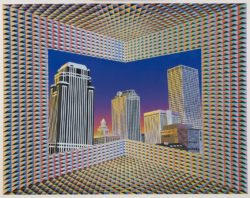Historic New Orleans Collection
THNOC Embraces the Contemporary
Art takes center stage as a new campus opens on Royal Street
Published: May 31, 2019
Last Updated: August 30, 2019

The Historic New Orleans Collection, gift of Judith L. Jurisch
Krista Jurisch, Cityscape, 1987. Gouache on paper.
The New Orleans urban landscape animates and contextualizes Art of the City: Postmodern to Post-Katrina, presented by The Helis Foundation—the debut exhibition in the center’s new Tricentennial Wing. The show illustrates the city’s multilayered character and confirms its significance as an incubator of cultural diversity.
Art of the City focuses loosely on the period from the 1984 Louisiana World Exposition through the present—a vital yet turbulent era in the life of the Big Easy. The design of the world’s fair and the art it exhibited fit into the postmodern movement of the day, which rejected established styles and cultural norms and embraced a diversity of perspectives and forms. The convergence of these ideas and this international event left a lasting imprint on the city and its artists. Krista Jurisich’s Cityscape was completed three years after the fair, to commemorate the redevelopment of the Poydras Street business corridor, and its electric, graphically pulsating view of downtown captures the postmodern focus on transition and permutation.
The exhibition’s other temporal bookend is the aftermath of the 2005 levee breaches and flooding following Hurricane Katrina. In Fats Got Out (2009), painter Gina Phillips comments on the story of Fats Domino being airlifted to safety from his flooded Lower Ninth Ward home. Depicting the legendary R&B singer and pianist levitating above the Industrial Canal in splendor, she renders him a mythical hero, rather than a Katrina victim. As expressed in these and many more examples, New Orleans has proven resilient, in no small part because of its ascending—and still incubating—ecosystem of culture and arts.
Art of the City is inspired by the ever-evolving patchwork of neighborhoods, architecture, cuisines, and music that history has wrought here. The artists represented have been moved by the city’s patina, its inhabitants, and their own individual passions. Their work details the mundane and the mysterious, sometimes in the form of a caress—as in Spring Willows (1995), Simon Gunning’s rendering of a New Orleans neighborhood scene—and other times a caution. No doubt, there has been a rush to document what at times feels fleeting, threatened, eroding.
Many of the works on display in Art of the City are drawn from the holdings of The Historic New Orleans Collection and capture nuances of this special place and time. The exhibition showcases work by contemporary artists with New Orleans roots as well as a sampling from deeply invested visiting artists and newcomers. Beyond the gallery walls, the New Orleans landscape has been enhanced by the peppering of public art over the last three decades. Whether permanent or ephemeral, these installations have woven indelible patterns into the fabric of the city (“the upholstered sewer,” according to Mark Twain). A map on the first floor of the exhibition spotlights a selection of these multidisciplinary works.
Programming is another integral component of Art of the City: film screenings, live performances, workshops, bike tours, dialogues, and more broaden its scope. As New Orleans enters its fourth century, Art of the City represents the diverse chorus of voices that has long distinguished this city and will shape its future.
